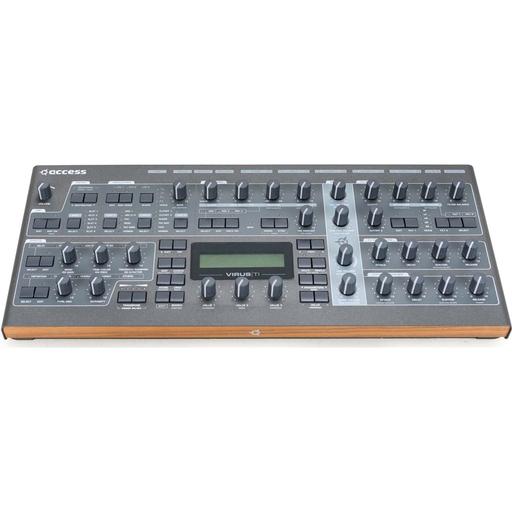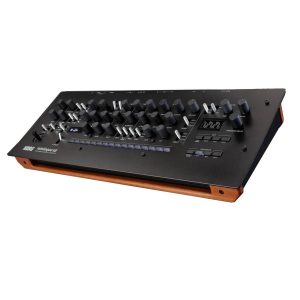Access Virus TI2 Desktop
$1,304.99
Get your perfect sound with the Access Virus TI2 Desktop, the greatest and most powerful hardware synthesizer for achieving incredible sound quality.
Compare
Description
The Access Virus TI2 Desktop Synthesizer is a powerful digital beast that has stood the test of time. It is widely considered one of the most advanced synthesizers of its kind, with cutting-edge features, pristine sound quality, and an intuitive user interface that makes it easy to use.
One of the standout features of the Virus TI2 Desktop Synthesizer is its sound engine. It boasts over 80 oscillators, with up to 16 voices of polyphony, which makes it capable of producing everything from classic analog synth sounds to modern, complex soundscapes. It also has a variety of filter types, including low-pass, high-pass, bandpass, and more.
Another impressive feature of the Virus TI2 Desktop Synthesizer is its modulation capabilities. It has three LFOs, two ADSR envelopes, and an extensive modulation matrix that allows you to route any modulation source to any destination. This gives you incredible flexibility and control over your sound.
In terms of connectivity, the Virus TI2 Desktop Synthesizer has everything you need to integrate it into your studio setup. It has a variety of inputs and outputs, including MIDI, USB, and audio inputs and outputs. It also has a built-in USB audio interface, which makes it easy to record directly into your DAW.
One of the unique aspects of the Virus TI2 Desktop Synthesizer is its VirusControl VST/AU plugin. This allows you to use the Virus as a hardware synth, but with the added convenience of being able to control it directly from your DAW. All of the synth’s parameters can be easily accessed and automated, making it a breeze to integrate into your production workflow.
Overall, the Access Virus TI2 Desktop Synthesizer is a powerful and versatile synth that is sure to impress even the most demanding producers and synth enthusiasts. Its advanced sound engine, modulation capabilities, and intuitive user interface make it a joy to use, and its robust connectivity options and VirusControl VST/AU plugin make it a versatile addition to any studio setup. If you’re looking for a top-of-the-line synthesizer, the Virus TI2 Desktop Synthesizer is definitely worth considering.
Access Virus TI2 Desktop properties
| Product name |
Access Virus TI2 Desktop |
| Brand |
Access |
| Type |
Synthesizers |
| Keys |
No |
| Drawbars/Sliders |
No |
| Pads |
No |
| Rotary Controls |
No |
| Modulation Wheel |
Yes |
| Pre-Programmed Rythms |
No |
| Pre-Programmed Songs |
No |
| Pre-Programmed Sounds |
No |
| Pre-Programmed Drumset |
No |
| Pre-Programmed Effects |
Yes |
| Built-In Tuner |
No |
| Portable |
No |
| Speakers |
No |
| Connections |
3.5mm (AUX), 6.3mm (1/4″RTS), Headphone, MIDI Through USB |
| Colour |
Black |
| Power Supply |
Electrical Cable to Wall Socket |
Frequently Asked Questions:
How do I properly program and edit sounds using the Access Virus TI2 software on a desktop computer?
Connect your Access Virus TI2 synthesizer to your desktop computer using a MIDI interface or USB cable. Download and install the Access Virus TI2 software from the manufacturer's website onto your desktop computer. Launch the Access Viris TI2 software and select "Edit" mode. This will allow you to program sounds directly into the synthesizer's memory. To create a new sound, press the "New" button or use the keyboard shortcut "Ctrl + N". You can also load an existing sound by selecting it from the bank list. Use the various parameters and sliders within the software interface to adjust different aspects of your sound. These may include oscillator waveforms, filters, envelopes, LFOs, and more. Listen to your changes in real-time by pressing the "Play" button or using the keyboard shortcut "Space". Save your new sounds by selecting "Save" from the menu bar or using the keyboard shortcut "Ctrl + S". You can choose whether to save your sound to a specific bank or create a new one. To edit an existing sound, select it from the bank list and make your changes as needed. Remember to save your edits when you're finished. When you're ready to load your sounds into the synthesizer, connect it via MIDI or USB and press the "Load" button within the software interface. Alternatively, you can transfer sounds using a SD card (for models with SD card slots) or an external hard drive connected to the "USB-Host" port on the back of the synth.
How can I optimize the sound design capabilities of my Access Virus TI2 desktop synthesizer for maximum potential?
To optimize the sound design capabilities of your Access Virus TI2 desktop synthesizer for maximum potential, follow these steps:
1. Familiarize yourself with the synthesis engine and user interface of the Virus TI2. The more you understand its various modules, parameters, and workflow, the better equipped you'll be to create unique and compelling sounds. Explore the factory presets that come with the synthesizer as a starting point for your own sound design experiments. Pay attention to how different settings affect the timbre, dynamics, and behavior of the oscillators, filters, envelopes, modulation sources, and effects. Utilize the Virus TI2's advanced modulation features, such as the Mod Matrix, the Animation feature, and the built-in LFOs and EGs, to create complex and evolving sounds. Experiment with routing different sources to different destinations, using the available quantization options, and adjusting the depth and response time of each modulation curve. Take advantage of the Virus TI2's polyphonic capabilities, as well as its ability to sync multiple oscillators together for rich and complex harmonics. Use techniques such as ring modulation, cross-modulation, and FM synthesis to create distinctive textures and timbres. Pay close attention to the Virus TI2's routing options, which allow you to split and layer different sounds within a single patch. This can be especially useful for creating complex pads or textural beds that contain multiple layers of sound. Utilize the Virus TI2's built-in effects, such as reverb, delay, distortion, chorus, phaser, and flanger, to add depth, space, and character to your sounds. These effects can be applied at both the source (pre) and destination (post) levels, which allows for a greater degree of control over their interaction with the sound source. Finally, don't forget to use your ears as your guide! Listen critically to the sounds you're creating, and make adjustments accordingly. Pay attention to factors such as frequency balance, harmonic content, dynamics, and decay time, and aim for a cohesive and musical result that serves your creative vision.
How can I optimize the processing speed and memory usage of my Access Virus TI2 Desktop synthesizer to achieve maximum performance?
To optimize processing speed and memory usage on your Access Virus TI2 Desktop synthesizer, there are a few steps you can follow:
1. Use presets sparingly - While the TI2 comes with many great presets, loading too many at once can slow down the processor and use up valuable memory. Stick to using only the presets that you need for your current project. Close any unused pages or applications - The TI2 has multiple pages for different functions such as editing, sequencing, and librarian. Make sure you close any pages that are not in use to free up memory and processing power. Reduce polyphony - Polyphony refers to the number of voices (notes) that can be played simultaneously. If you're experiencing processor overload or running out of memory, consider reducing the polyphony to a lower value. This will allow for smoother performance and less lag. Use real-time effects sparingly - The TI2 has a range of real-time effects such as reverb, delay, and chorus. While these can add depth and richness to your sounds, using too many at once can lead to processor overload and memory usage issues. Use these effects sparingly and only on the sounds that require them. Save often - To avoid losing any work due to a system crash or power outage, be sure to save your projects frequently. This will also help you keep track of any changes you make and make it easier to go back and revise your work if needed. Use an external MIDI controller - The TI2 has a built-in keyboard, but using an external MIDI controller can free up processing power and memory by reducing the load on the internal keyboard. This will allow for smoother performance and faster response times. Update firmware regularly - Access releases updates to the TI2's firmware to improve performance, fix bugs, and add new features. Be sure to check their website regularly for any available updates and install them as soon as possible. By following these steps, you can optimize processing speed and memory usage on your Access Virus TI2 Desktop synthesizer and achieve maximum performance.
What steps are necessary to ensure optimal performance and compatibility of a Access Virus TI2 desktop synthesizer within a studio or live music setting?
Connect the Access Virus TI2 synthesizer to a stable power source using the included AC adapter. Make sure the power cable is securely plugged in and the unit is turned on. Connect the synthesizer to a computer running the latest version of Access Virus Center software via USB. This will allow you to update the firmware, load presets, and save your own sounds. Connect the synthesizer to a MIDI interface or a keyboard with MIDI out capabilities using the 5-pin DIN MIDI in and out ports on the back of the unit. Adjust the settings on the Access Virus Center software to match your studio or live performance setup. This includes setting up your preferred MIDI channel, selecting a preset or creating your own sounds, and adjusting output levels. Optimize the sound quality by ensuring that the synthesizer is properly grounded using an appropriate ground lift adapter. This will help prevent ground loop issues and interference. Test the compatibility of the Access Virus TI2 with other studio or live performance equipment such as mixers, amplifiers, and monitors. Make sure all devices are connected and configured correctly. Check that all cables and connections are securely in place to prevent any unexpected disconnections during performance. Monitor the output levels of the synthesizer and other equipment using a sound level meter or a mixer's built-in meters. Make sure the levels are appropriate for your studio or live setting. Test the Access Virus TI2 in a variety of settings to ensure compatibility with different MIDI controllers, DAW software, and hardware configurations. This will help you identify any issues or limitations that may arise. Regularly clean and maintain the Access Virus TI2 synthesizer to keep it functioning optimally over time. This includes wiping down the surface with a soft cloth and avoiding exposure to moisture or extreme temperatures.
Can you explain how to properly calibrate the oscillator detuning and vibrato settings on the Access Virus TI2 Desktop to achieve a desired waveshaping effect?
1. Oscillator Detuning**: The Virus TI2 has two oscillators, which can be detuned from each other to create a richer sound. To calibrate the detuning, follow these steps:
* Set both oscillators to sine wave. Adjust the "Detune" control until you get a subtle, pleasing detuning (around 10-20 cents). You want to hear a gentle "wobble" or "fluttering" effect when listening to a single note. Once you've set the initial detuning, adjust the "Detune Spread" control to widen or narrow the detuning range. This will help you achieve the desired waveshaping effect. Vibrato**: The Vibrato section on the Virus TI2 allows you to add a dynamic, pitch-bending effect to your sound. To calibrate the vibrato, follow these steps:
* Set the "Vibrato" control to around 10-20% (depending on the desired amount of vibrato). Adjust the "Depth" control until you get a pleasing, subtle vibrato effect. Experiment with different "Waveforms" for the vibrato (e. Waveshaping**: Now it's time to combine the oscillator detuning and vibrato effects to create a unique waveshaping effect. Try the following:
* Set the "Waveshape" control to around 10-20% (depending on the desired amount of waveshaping). Adjust the "Amount" control until you get a pleasing, subtle waveshaping effect. Experiment with different "Waveforms" for the waveshaping (e. Some tips to keep in mind:
* Start with small adjustments and gradually increase or decrease the settings as needed. This will help you avoid over-processing your sound. Listen carefully to how each setting affects the overall sound. You may need to experiment with different combinations of oscillator detuning, vibrato, and waveshaping to achieve the desired effect. Don't be afraid to push the limits of each control. Sometimes, extreme settings can lead to interesting, unexpected effects. By following these steps and experimenting with different settings, you should be able to achieve a unique and pleasing waveshaping effect on your Access Virus TI2 Desktop.
Before you buy Access Virus TI2 Desktop








Reviews
There are no reviews yet.